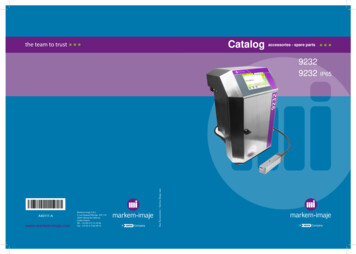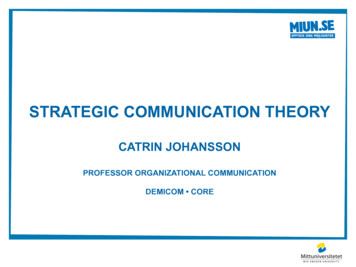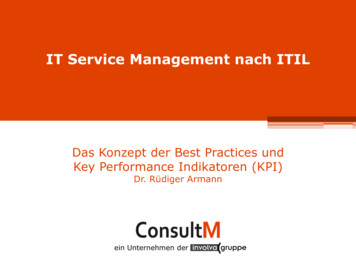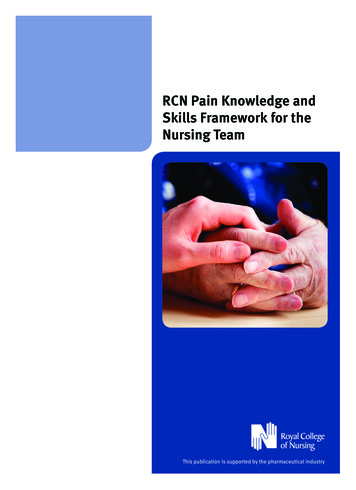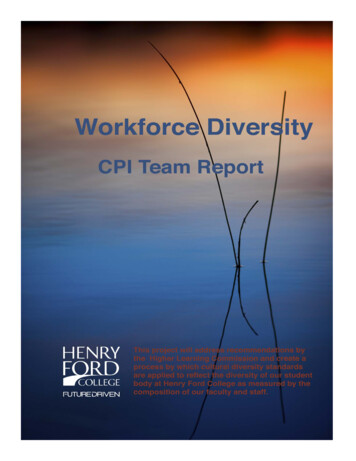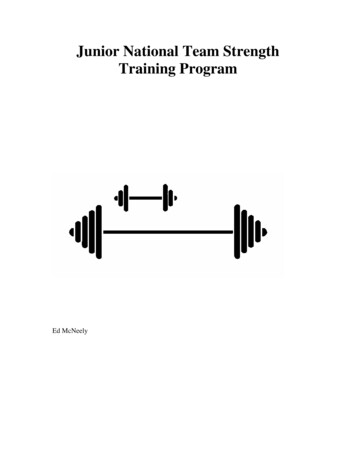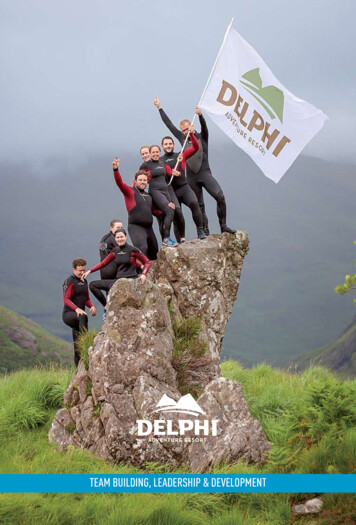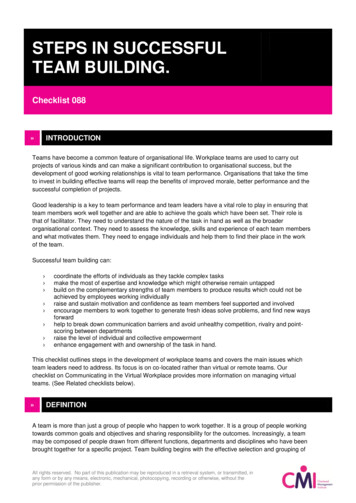
Transcription
Crisis Communication PlanGENET RémiGIRODS CharlèneLIS AnnaMARINIER OlivierAnglo Group C05Strategic Communication ‐ Team 1 & 3Crisis Communication PlanNike Inc.Duncan ScottYears 2008/20091
Crisis Communication PlanSummary1.Company background information . 3Portfolio . 4Executives:. 4Company’s history. 4Future strategies:. 53. SWOT & Industry Analysis . 6Industry analysis . 64. Potential crisis . 75. Introduction . 106. Crisis communication team. 107. Positioning. 118. Media policies and procedures . 129. Sample new release . 1410. Collateral Materials . 1511. Key audience . 1512. Recommended Evaluation and Follow up . 1613. Nike Crisis. 1814. Sources . 232
Crisis Communication Plan1. Company background informationNike Inc. is a company which is on the stock exchange in New York. This company isworldwide leader on sport market since 1990, just before Adidas. The company was foundedin 1972 and headquarter is close Beaverton in Oregon. Actually, the chairman is Philip h.Knight and the chief executive officer is Mark Parker. Nike’s turnover was 11.9 milliard ofEuro in 2007. Its famous logo was ordered in 1971 by Phil Knight, it called Swoosh and itwas designed by a design student.The graph below shows the repartition of Nike’s turnover:The main market of Nike is United State of America, but the company realizes about 56% ofits sales outside of USA like the graphic shows:3
Crisis Communication PlanTo develop its brand image, Nike has multiplied sponsoring with sportsman, for example intennis with Rafael Nadal or Roger Federrer, or with teams like in Football (Arsenal, Juventusof Turin) or Rugby (French National Team). In this field the company has stolen severalmarkets at its first competitor Adidas. Since, its crisis with labor child, the company tries toimprove its brand image to stay the leader on its market. But in spite of all its effort on worksconditions, the company always employed salaries in Asia to reduce costs. For example, Nikedesigner and chemist are based on Saigon and paid 5 per hour whereas shoes are sold 100.PortfolioNike Inc. owns different brands, which is its subsidiaries. Its portfolio is composed of: Cole Haan which designs and distributes dress and footwear and accessories for menand women. Converse Inc. is the famous brand of shoes. Hurley International LLC is specialized in surfing, skateboarding and snowboardingequipments. NIKE Golf designs all equipments for golf (bag, balls, shoes, accessories ) Umbro Ltd. is specialized on football sportswear.Executives:Philip H. Knight as Chairman of the BoardMark Parker as President and CEO of Nike IncChalie Denson as President of Nike brandCompany’s history1950s: The stories of Nike start with two ingenious men (Bill Bowerman and Phil Knight)who want to revolutionize the athletic sport. To begin they were distributor of Tiger shoes inUnited States which is a Japanese firm.1960s: They sold the first Tiger shoes in 1964 and at the same time the two men tried todesign theirs owns wears. 1965 the start-up is created and called ‘Blue Ribbon Sport’ based inOregon.1970s: They created their fist products brochures, ads and marketing tools. Moreover, the firstretailer was created in California. 1971 the name changed the name for ‘NIKE’, the logo andtheir design. The two men started to sell their own products and sponsored Prefontaine whowas the beginning of Nike’s success.4
Crisis Communication Plan1980s: Nike launched its famous and brand new technological shoes called “Nike Air” andbecame a publicly traded company. As Nike focused on its industrial shoes, it has missed theopportunity of a growing aerobic market but came back in front of its opponents by riskingdealing with Michael JORDAN in NBA. Years later, Nike invested in marketing advertisingthe slogan “Just do it”.1990s: It created their first retail “Niketown” in Oregon and all around the world later. AsMichael JORDAN, Nike multiplied sponsoring of sport’s professionals. A new brand wascreated: Nike Golf.2000s: Nike has found new marketing strategies involving a partnership with furtherworldwide events as Olympic Games and tournaments.October 2007: Nike acquires the Umbro’s firm.February 2008: Nike wins a new market; the company becomes the official French teamfootball supplier against Adidas. And during the Chinese New Year’s Eve the firm becomesthe official sponsor of Olympic Games.Future strategies:The main objective of the American firm is to obtain new markets. To reach its aim,the company will establish subsidiaries in emerging countries. Moreover, Nike wants toenforce its power on Europe market with developing product on main market (football andtennis).5
Crisis Communication Plan3. SWOT & Industry AnalysisStrengths: Very competitive organization and strong spirit of competition Strong research and development in order to innovate permanently. Nike does not own manufactory so they are able to produce only where they canproduce cheaply in order to sell at the lower price. If prices raise Nike change theplace production. Number one sports brand in the world. The famous swoosh is instantly recognisable.Weaknesses: Most of the incomes come from footwear whereas Nike has a diversified range ofproduct. If footwear market share fall down Nike would be in danger. Most of the retailers sale other brand than Nike so they are able to bargain prices.Opportunities: Nike does not reach only people who buy Nike product to practice sport. Nike seemsto be perceived as a fashion brand by young people. Possibility to develop products as sunglasses, jewellery in order to increase profits. Emerging markets as India have a new richer generation of consumersThreat: Costs and margins are not stable over long periods of time. The market is very competitive. The Nike model is copied by a lot of brands (low costof production and high selling value). Retail sector become more and more price competitive.Industry analysisNike’s Porters Five forces:The threat of substitute products is really important for Nike. The sector is reallyconcentrated; there are a huge number of brands who sale similar products compared to Nike.Moreover, there are a lot of discounters (Go Sport, Decathlon, Retailers brands.) who are athreat for Nike because of the decrease of purchasing power.6
Crisis Communication PlanThe threat of the entry of new competitors. Because of the global aspect from Nike, the brandhas to fight against a lot of new brands which can be created in the whole world. There are nota lot of barriers to entry on sportswear markets; we can see the creation of a lot of “littlebrands”.The intensity of competitive rivalry is really important. Rivals compete use an aggressivestrategy in order to gain market shares. The rivalry can be about the product himself(innovation, design .) with Adidas for example, or about the price (with retailers’ brands forexample).The bargaining power of customers with the decrease of purchasing power becomes moreimportant with time. Their price sensitivity is increasing and because of the positioning ofNike (high price of sales) this aspect has to be taken in account by the brand.The bargaining power of suppliers is important too because of the concentration of the sector.As we saw before retailers can choose not to work with the brand if prices are too high. Withthe huge concentration Nike has to take in account seriously this aspect.4. Potential crisisTo extrapolate the potential crisis that the company may face we must study at first theformer crisis that Nike had to surmount and how it succeeded in its difficulties.Since the nineties, the public opinion became aware of the fact that Nike did not respect theHuman Rights during its production process. In fact, Nike does not own any plant, itsproduction is distributed in various (40) plants in different countries where the labour cost isvery cheap. These plants are called “sweatshops” because of the infernal conditions ofworking. Nike had been accused to pay its employees under the threshold of subsistence.The “sweatshops” employ some children (in Asia) in order to find a cheaper and more servileworkforce. The public opinion accused Nike to employ children and to practice psychologicaland corporal punishment on the employees.7
Crisis Communication PlanIn 1992, Nike created a “behaviour code” in order to stop criticises. This code indicates theattitude that the subsidiary has to follow: The subsidiary cannot use forced workThe work of children under 18yo (or 16yo) is forbiddenThe salary cannot be reduced because of a disciplinary fault.These measures were considered insufficient by the public opinion and a boycott appeared.During the meeting of the shareholders in 1997, some demonstrators gave a letter signed by45 organisations from around the world. This letter condemned the abuses which occurred inthe plants and urged the leaders to stop the disrespect of the Human Rights.In 1997 testimonies of employees who worked in Nike’s plants were diffused in Americannewspapers like Thuy and Lap (two workers of a Vietnamese plant) who said “You have tomeet the quota before you can go home. She hit all 15 team leaders in turn from the first oneto the fifteenth. The physical pain didn't last long, but the pain I feel in my heart will neverdisappear.” The workers who spoke to the journalists were fired despite the fact that thesetestimonies were confirmed by a report of “The Board of Monitoring of the LabourConditions” of the Vietnam.This kind of testimony obliged Nike to react and to show that Nike was concerned by thesesocial problems and tries to change the situation.In order to preserve its reputation, Nike decided to reinforce its “behaviour code” in 1997:establishment of trade-union freedom, opening of a “department of the work conditions”.Nike decided to adhere to the FLA (Fair Labour Association) in 1998 in order to validate itsaction in its plants. Nike has to be controlled by a NGO which check if the labour conditionsare respected in its plants. This NGO has to give to the shareholders and to the consumers areport to show the situation in the plants.This action gave Nike more credibility and permitted to diminish the rumors and the boycott. We can see that Nike had always been attacked on the working conditions in theplants; it is one of the biggest weaknesses of Nike. So we have to pay attention,because Nike may be attacked again on the social and working conditions by thepressure groups or by some lobbies Nike can have problems in the plants due to the difficult conditions of working(suicide, demonstrations.)8
Crisis Communication Plan Another important point is the environmental awareness. Nike could be attacked onthis point, but Nike can argue that it had been elected the “greenest big firm” in theworld (StonyField Farm is second and IBM third) by ClimateCounts in 2007. Nike can meet problems with its production (shoes, clothes ) like toxicity,dangerousness of some products Another boycott of Nike can occurred because of the pressure groups. A crisis can occurred if one of the athlete sponsored by Nike is accused of doping.This situation can have a big impact on Nike’s reputation. A fiscal fraud can be another crisis that Nike could have to overtake. A bad behavior of a director of Nike or of an athlete sponsored by Nike can tarnish theimage of Nike9
Crisis Communication Plan5. IntroductionThe following part will be really useful in case of crisis because this is the procedurewhich teaches us how to react if an emergency occurs. This part answers to the questions“What we have to do? Who do we have to inform? How should we communicate? Who haveto explain the problem? Etc ”We do not have to improvise our reaction; we have to be relevant, effective and quick in ourtreatment of the crisis. This part is here to clarify some points, in order to win some time inour reaction during the crisis. It is like a “guide” even if some points can be adjusted if thecrisis
worldwide leader on sport market since 1990, just before Adidas. The company was founded in 1972 and headquarter is close Beaverton in Oregon. Actually, the chairman is Philip h. Knight and the chief executive officer is Mark Parker. Nike’s turnover was 11.9 milliard of Euro in 2007. Its famous logo was ordered in 1971 by Phil Knight, it called Swoosh and it
